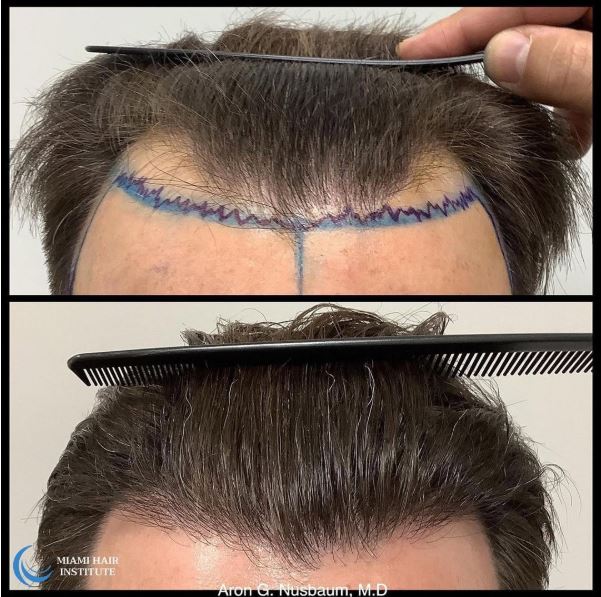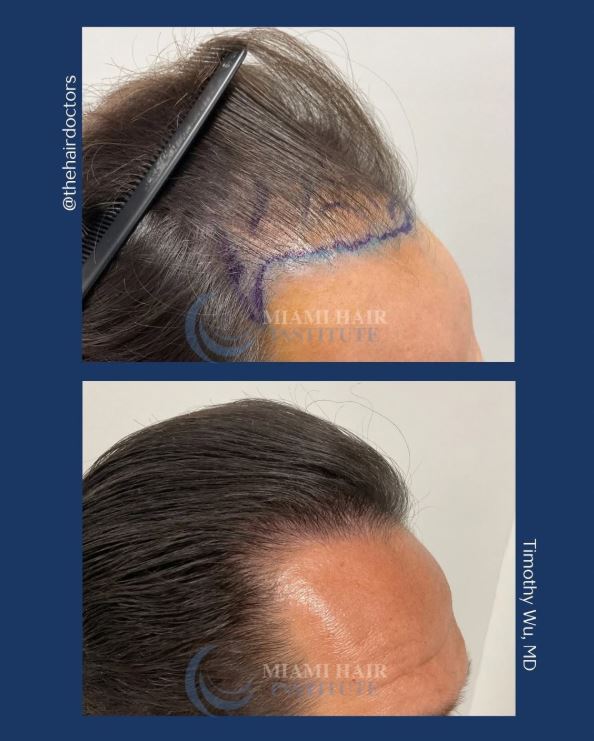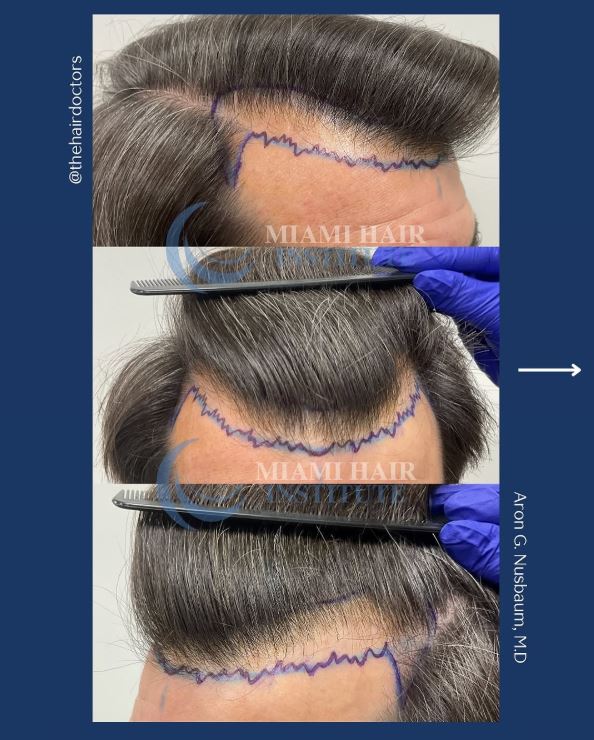
Robotic FUE, also known as ARTAS®, is an advanced hair restoration technique that uses a robotic arm and digital imaging to extract follicular units with speed and precision. At Miami Hair Institute, we use robotic FUE to help patients minimize scarring, shorten recovery time, and achieve natural-looking results.
In this article, we’ll address real concerns patients share with us about robotic FUE, compare it with manual techniques, and explain when it may be the right choice for your hair restoration journey.
What Is Robotic FUE?
Robotic FUE, most commonly performed with the ARTAS® system, is a type of follicular unit extraction that uses artificial intelligence and a robotic arm to assist with graft harvesting. The system takes high-resolution digital images of the donor area and creates a 3D model of your scalp. This allows the robot to identify and select follicular units (small groups of 1–4 hairs) with the right angle, orientation, and density for extraction.
Once the grafts are mapped, the robotic arm uses a punch tool to score around each follicular unit with consistent depth and spacing. This helps reduce the risk of human error and transection (damaging the follicle during removal). The surgeon and team then remove the scored grafts and prepare them for implantation.
The technology is designed to make the harvesting process faster, more precise, and less invasive. Tiny circular punches replace the need for a long linear incision, which means minimal scarring, faster healing, and the ability to wear your hair shorter without visible donor scars.
It’s important to note that the robot doesn’t design your hairline or place the grafts. That part is still done by your surgeon. Robotic FUE is a tool that improves consistency and efficiency, while artistry and natural results still rely on surgical expertise and artistry.
Is Robotic FUE More Effective Than Manual FUE?
Robotic FUE was designed to make graft harvesting faster and more consistent. The system uses algorithms to calculate the angle, depth, and spacing of each extraction, which reduces the risk of fatigue-related errors that can happen with manual FUE. In theory, this means fewer damaged follicles and more usable grafts.
In practice, effectiveness depends on both the technology and the surgeon using it. While the robot can improve precision, it cannot replace surgical judgment. Manual FUE gives the surgeon complete control, which can be an advantage in areas with variable hair angles, finer hair, or complex cases.
At Miami Hair Institute, we use robotic FUE when it offers the best outcome, but we also perform manual and hybrid FUE. The right method is determined during consultation, based on factors like hair type, donor density, and the size of your procedure.
Will the Robot Overharvest or Damage the Donor Area?
Overharvesting is taking too many grafts from one spot and leaving the donor area looking thin or patchy. The ARTAS® system is designed to avoid this by mapping the donor zone and spacing extractions evenly. It uses algorithms to calculate density and leave behind enough hair for natural coverage. However, the robot only follows the programmed plan. If the settings or strategy are poor, overharvesting can still happen.
At Miami Hair Institute, our surgeons carefully program the extraction pattern and oversee every stage. We also combine robotic precision with human judgment, ensuring the donor area remains healthy and uniform.
Hybrid FUE — ARTAS® robotic system with the skill of manual FUE extraction
Does Robotic FUE Hurt More?
Both robotic and manual FUE are performed under local anesthesia. You may feel small pinches from the numbing injections, but once the area is anesthetized, discomfort during extraction is minimal. Some patients report a tapping or vibration sensation from the robotic arm, but not pain.
After the procedure, it’s normal to experience mild soreness or tightness in the donor area for a few days. This is the same whether grafts are harvested manually or with the robot. Over-the-counter pain medication is usually all that’s needed, and most patients return to regular activity within a few days.
Can Robots Handle Different Hair Types and Angles?
Robotic FUE works best in donor areas where hair grows in uniform directions with predictable angles, typically the back and sides of the scalp. The ARTAS® system uses digital imaging to track follicle orientation, but it can be less efficient when hair angles change quickly, such as in the temples or crown.
Hair type also matters. Dark, straight hair with good contrast against the scalp is easiest for the robot to identify. Lighter hair, gray hair, and very curly hair can be more challenging, since the system relies on visual mapping. In some cases, a special dye is used to improve contrast, or the surgeon may switch to manual FUE for areas the robot cannot easily harvest.
During your consultation, our surgeons will evaluate your hair type, density, and growth pattern before recommending robotic FUE. For many patients, robotic extraction works very well. For others, a hybrid approach that combines robotic and manual techniques produces the most natural results.
Does Robotic FUE Look Natural?
Yes and we’re proud to say that we’ve consistently produced natural results with robotic FUE. The ARTAS® system’s strength is in harvesting grafts with consistency and precision, but it does not design your hairline or place the grafts. Those steps are done entirely by the surgeon.
Natural-looking results come from artistry and experience: planning a hairline that fits your age, face shape, and future hair loss pattern, and placing grafts at the right angle and density. The robot assists by providing high-quality grafts, but the surgeon’s skill determines how they grow in.

Dense, natural hairline with 1889 follicular units via ARTAS Robotic FUE at only 6 months

Hybrid FUE hair transplant with 1,715 follicular units 1 year post-op (Robotic FUE + manual extraction)

Hybrid FUE result 1,716 follicular units just 6 months (Robotic FUE + manual extraction)
Is Robotic FUE Right for Me?
Robotic FUE is a great option for many patients, but it’s not always the best choice for everyone. It tends to work best for men and women who:
- Have straight or slightly wavy hair in the donor area, where the robot can easily identify and extract follicles.
- Prefer to avoid a linear scar so they can wear their hair shorter.
- Want a minimally invasive procedure with faster healing and less downtime.
- Need a moderate number of grafts and value precision and consistency in harvesting.
Patients with very curly hair, very light hair, or advanced hair loss may be better candidates for manual FUE or a hybrid approach. That’s why the most important step is an in-person evaluation.
Even with robotic FUE, your hair transplant results rely on who is performing the surgery because natural hairlines require human touch. Our board-certified surgeons, Dr. Aron Nusbaum, Dr. Timothy Wu, and Dr. Bernard Nusbaum, have over 50 years of combined experience and have performed 20,000+ hair transplants with undetectable results, including robotic FUE.
Call us today at +1 305-448-9100 to schedule your consultation and take the first step toward restoring your confidence. We are conveniently located at 3850 Bird Road, Suite 102, Miami, FL 33146, serving patients in the South Florida area, including Miami, Coral Gables, Miami Beach, Gladeview, South Miami, and more.
Frequently Asked Questions
How much does robotic FUE cost?
Cost varies based on the number of grafts, but it is generally comparable to manual FUE. We will provide you with a personalized cost estimate during your consultation.
Does robotic FUE leave scars?
Yes, but only tiny circular marks where grafts are removed. These typically heal quickly and are not visible with short hair.
How many grafts can the robot transplant in one session?
On average, several thousand grafts can be harvested in a single day, depending on donor supply and the patient’s goals.
Is robotic FUE safe?
Yes, when performed under the supervision of an experienced surgeon like Dr. Nusbaum. Risks are similar to manual FUE, including temporary swelling, discomfort, or folliculitis.
Can robotic FUE be combined with manual FUE?
Yes. We often use hybrid FUE to maximize precision, graft yield, and artistry. But it’s still case-by-case. A private consultation with us will help you determine which technique is right for you.

